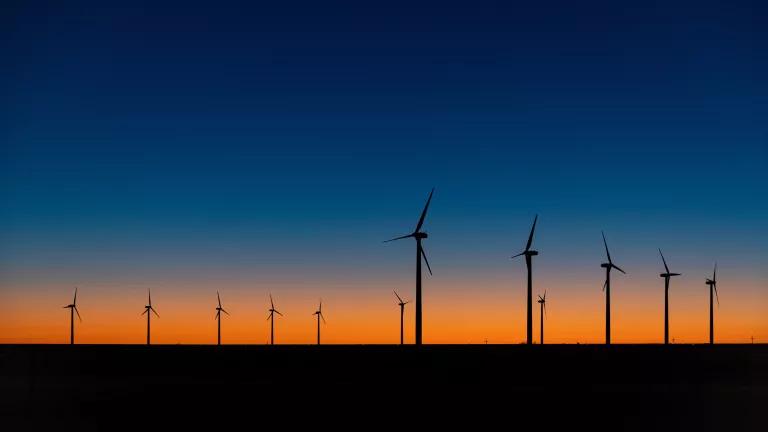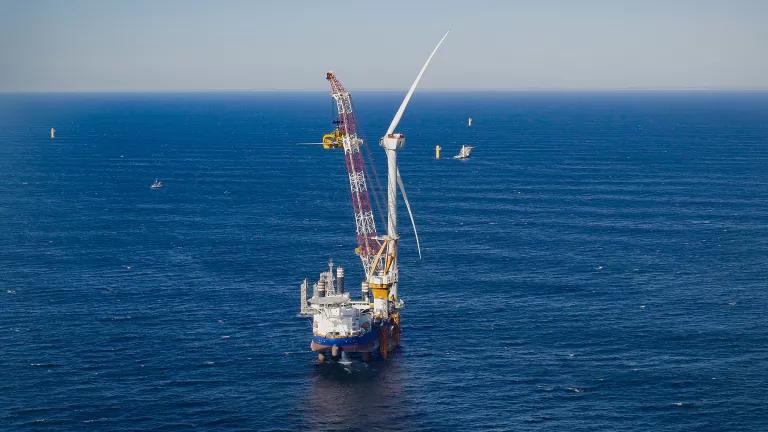The DOE Is Innovating for the Challenges of Today and Tomorrow
Here is how the DOE’s research, development, demonstration, and deployment activities drive the clean energy transition.

Werner Slocum/NREL, 62957
In the face of mounting pushback and legislative bills meant to stymie clean energy development, the U.S. Department of Energy (DOE) continues pushing forward in facilitating the clean energy transition to strengthen our national energy security. As we face a divided Congress and an uncertain 2024 election, support for the DOE must not waver. The department invests in critical areas of U.S. energy supply and demand—bolstering U.S. competitiveness in the global clean energy market while delivering billions of dollars in energy cost savings to American homes and businesses and creating hundreds of thousands of jobs. The DOE’s investments spawn and enable transformative clean energy technology solutions and companies—including major advancements in solar panels and the scaling up of such companies as Tesla. Looking toward the future, the DOE must continue to capitalize on its track record of success by shifting the department’s focus toward the selection of promising, high-impact projects that bring us closer to a net zero economy.
To scale technologies and deliver benefits to U.S. communities and businesses, the DOE leverages a multilevel approach that incorporates research, development, demonstration, and deployment (RDD&D) activities. Research and development activities are critical to accelerating innovation and improving the discovery of cutting-edge technologies that can lead to commercial application, while the DOE’s demonstration and deployment activities are vital to proving the economic viability of nascent energy technologies to accelerate widescale adoption. These activities work holistically to transform basic research into commercially viable and scaled up technologies that deliver huge benefits to American households and the economy.
Let’s examine the RDD&D life cycle and the department’s notable successes further. (In a forthcoming blog, we will spotlight the DOE’s main challenges and some of the key solutions that are necessary to address them.)
Clean energy innovation and RDD&D life cycle: Bringing to bear U.S. ingenuity to create new clean energy solutions
Through its National Laboratories and applied energy programs, the DOE has radically transformed America’s energy landscape by developing and advancing transformative energy technologies, including:
- In 2019, the DOE’s Advanced Research Projects Agency-Energy (ARPA-E) program established exploratory topics to improve the extraction of battery materials for electric vehicles and storage applications. This could lead to reducing supply chain barriers and lowering the cost of batteries.
- In 2022, the DOE partnered with heat pump manufacturer Lennox to develop cold-climate heat pump technology to improve utility efficiency and affordability.
- In 2023, the DOE provided funding for nationwide research and development of grid resilience and efficiency to meet the growing energy demand and weather disruptions.
The DOE's work does not stop at the laboratory door but rather extends through the full innovation life cycle. A key next step is engaging the private sector and partnering with investors and companies to accelerate the scale-up of innovative solutions. The Office of Technology Transitions (OTT) works to bring entrepreneurs together with experts and capital to spur ventures in new technologies. In 2023, OTT awarded $2 million in funding to support energy start-ups and entrepreneurs shaping regional energy innovation. The extension of expertise and finance ensures that impactful research does not languish in institutions.
Even so, successful lab-scale technologies often do not translate into commercially viable technologies that are widely adopted by the market. This failure is known as “the valley of death”—the stage where a nascent technology has graduated from lab-scale and pilot projects but is still perceived as too risky for private sector investment. Weathering through the valley of death requires well-designed public support to help lower the risks of novel technologies and spur private sector investments. The DOE’s relatively new Office of Clean Energy Demonstrations (OCED) does just that. OCED was established by the Infrastructure Investment and Jobs Act, which, in combination with the Inflation Reduction Act, appropriated more than $27 billion in funding for OCED. These funds are for establishing the large-scale deployment of nascent clean energy solutions for the purpose of “de-risking” them and spurring private sector investments and widespread commercialization. Most notably, OCED recently announced the selection of seven hydrogen hubs distributed throughout the United States, in what is one of the largest public investments in clean energy manufacturing and deployment in U.S. history.
Finally, de-risking technologies is not sufficient alone to enable wide-scale commercialization and market uptake, and concessional loans and grants are often necessary to catalyze a technology’s scale-up. Through the DOE’s Loan Programs Office (LPO), competitive loan terms are issued to firms interested in scaling up existing renewable clean energy technologies. For example, the LPO’s Energy Infrastructure Reinvestment program enables projects to retool, replace, repower, or repurpose sites for new, greener energy infrastructure. The LPO ensures that the technologic benefits of established renewable energy sources and energy efficiency practices reach businesses, communities, and households across the United States.
DOE’s impact on better living: Jobs, wallets, health
Connecting DOE success to everyday consumers, these RDD&D investments translate into greater adoption of clean energy technologies that create American jobs, lower energy costs, and bolster public health and the U.S. economy. The latest U.S. Energy & Employment Report highlights nearly 300,000 energy-related jobs for a total of 8.1 million people employed in U.S. energy sectors. Many of these jobs are in industries that were bolstered by government investments and tax incentives for green energy and electric vehicles. The DOE’s role in this job creation cannot be overstated.
Moreover, as we have witnessed recently, global crises can increase variable fossil fuel prices by as much 30 percent, whereas renewable energy costs are not linked to fluctuating fuel prices and are therefore fairly . With the DOE’s investment in renewables, people can expect consistently affordable access to energy. Additionally, the Weatherization Assistance Program (WAP), which is housed within the DOE’s Office of State and Community Energy Programs (SCEP), has served an estimated seven million households—saving them, on average, $372 annually and approximately $2.6 billion collectively since 1976. In fact, with every $1 invested in WAP, it returns $2.78 in related energy benefits—a more-than-twofold return on investment.
Renewable energy funds also help minimize the negative health effects linked to fossil fuels, including premature deaths, hospital visits, and other impacts. Globally, multiple universities estimate that one in five deaths can be attributed to fossil fuel air pollution. In the United States alone, 2021 research placed a conservative cost estimate of more than annually from these various health impacts. The DOE must continue to invest in renewables to ensure that all Americans can obtain good health, affordable energies, and jobs.
A DOE for the future
Despite its immense success and efforts to date, the DOE’s work is far from finished, which is why continued and consistent support from lawmakers, organizations, and the public is critical. The DOE’s research arm must continue to explore technologies that can rapidly improve the U.S. energy economy in the near term and those that can radically reshape it in the long term to meet our midcentury climate objectives. For instance, support and funding for OTT and OCED must not falter, as they are critical to the accelerated dissemination, deployment, and commercialization of emerging technologies.
Additionally, the LPO and SCEP must expand their efforts in financing established technologies and modernizing communities. Despite recent setbacks in offshore wind loan financing, the LPO has a remarkably low loss rate record of 3.2 percent. In contrast, the high up-front capital costs of renewable energy technologies limit private sector interest in issuing loans. Likewise, the twofold returns of SCEP’s weatherization programs warrant continued and expanded support. In the face of high interest and inflation rates, the LPO and SCEP should be further empowered to bridge financing gaps and meet stakeholder needs.
The DOE’s role in research, development, demonstration and deployment of clean energy technologies is critical to America’s clean energy transition, which is essential to ensuring our future of energy security and climate resilience. The challenges of the energy transition require a reinvigorated DOE that is focused on promising projects that maximize climate emissions reductions to meet our net zero future.


